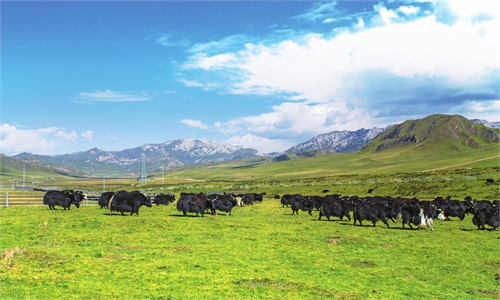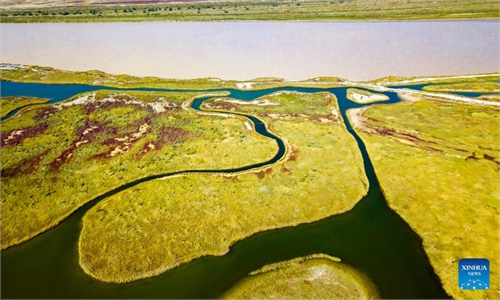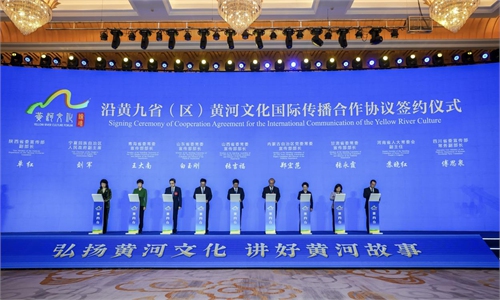IN-DEPTH / IN-DEPTH
Ecological protection of Yellow River estuary resonates with historical transformation of ‘city of oil’ into ‘city of wetlands’
Sanctuary and oasis
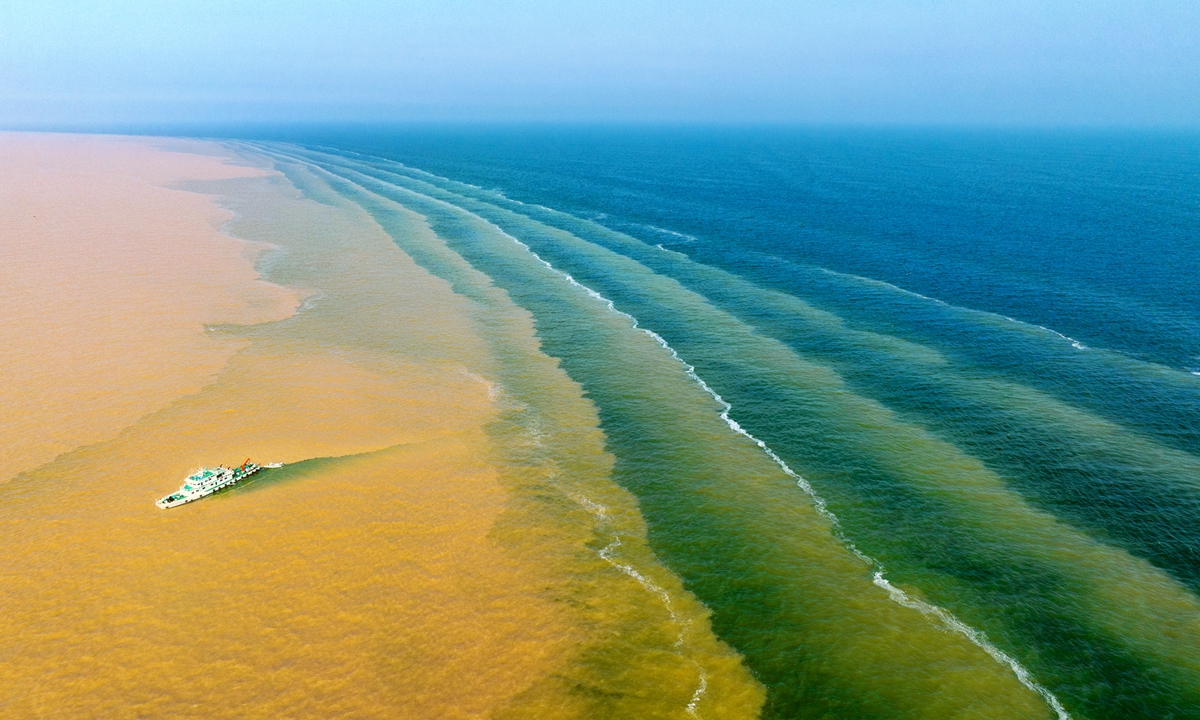
The Yellow River estuary in Dongying, East China's Shandong Province, exhibits a distinct demarcation between seawater and river water. Photo: Courtesy of Zhao Liying
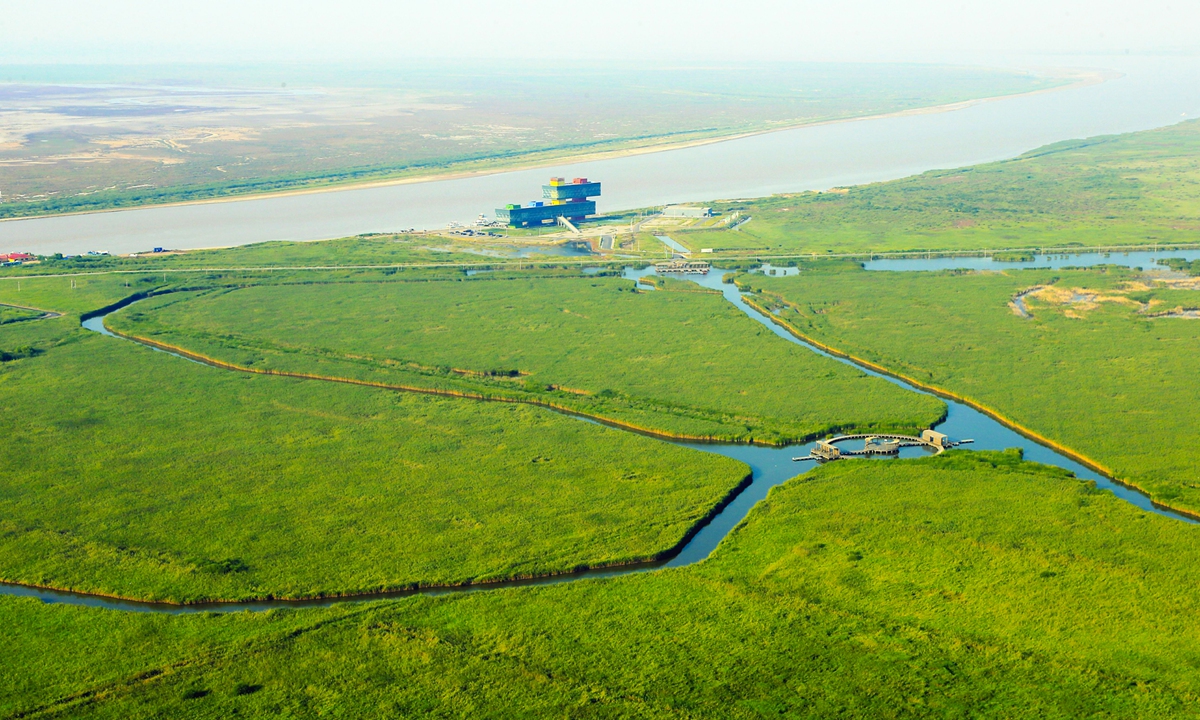
An aerial view of the Yellow River Delta National Nature Reserve in Dongying, East China's Shandong Province. Photo: Courtesy of Hu Youwen
In early May, the land of the Yellow River Delta in Dongying, where the Yellow River flows into the sea in East China's Shandong Province, was particularly lively.In the Shengli Oilfield's Liuhu oil production management area in Dongying, which is located within a wetland park, tourists stroll through the lush trees and pumping machines. While in the city's Yellow River Delta National Nature Reserve, bird flocks swarm the sky.
Flowing for about 5,464 kilometers through nine provinces and autonomous regions, the Yellow River merges into the Bohai Sea in Shandong. The sediment carried by the river deposits at the estuary, forming the "youngest delta in China" - the Yellow River Delta. This fertile land is also home to China's second-largest oilfield, the Shengli Oilfield, and forms the most extensive and intact wetland ecosystem in China's warm temperate zone.
In recent years, by promoting green, low-carbon, and environmentally friendly energy production and management, introducing high technology and ecological water replenishment in protecting the regional water and soil environment, Dongying is transforming from a "city of petroleum" to a "city of wetlands."
This historical transformation reflects China's unremitting efforts in promoting the harmonious coexistence between people and nature, protecting the environment of the estuary of the Yellow River and promoting high-quality development of a typical petroleum resource-based city.
Green shift of an energy city
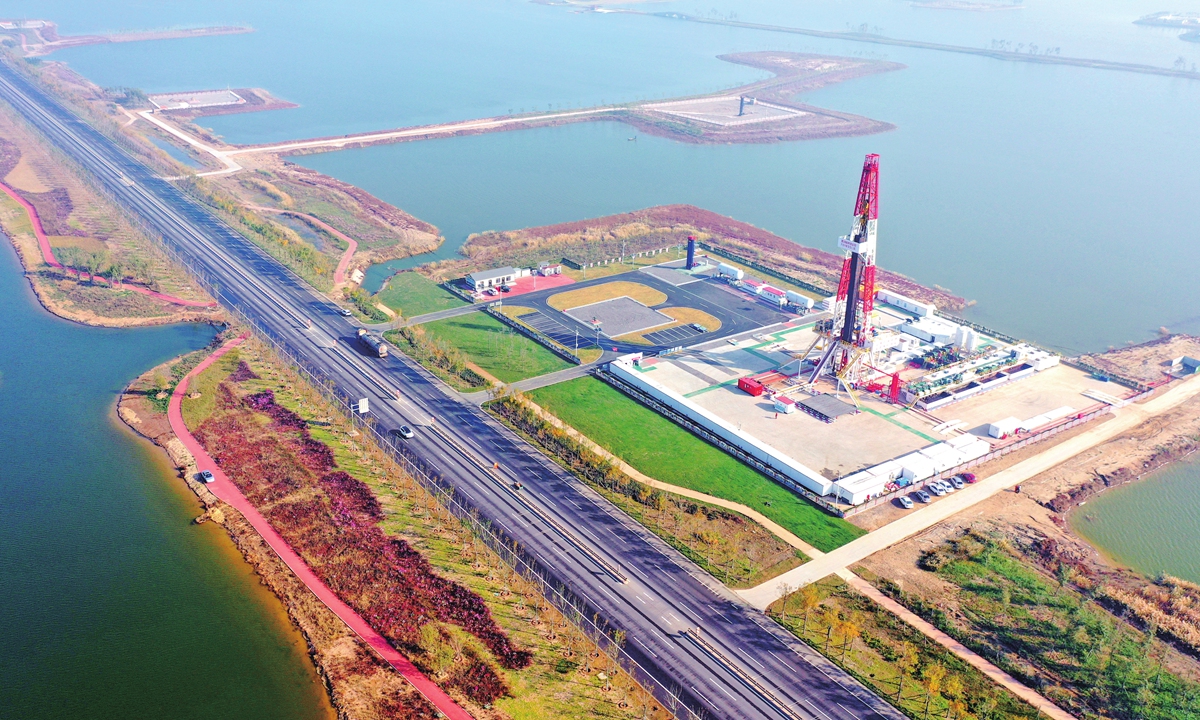
An aerial view of the Qilu Petrochemical-Shengli Oilfield carbon capture, utilization and storage (CCUS) project in Dongying, East China's Shandong Province. Photo: VCG
In the Yellow River Delta, oil and water are a pair of concepts that cannot avoid discussion.As the main producing area of Shengli Oilfield, the city of Dongying was built for oil and has established a complementary industrial system. As of September 2022, the Shengli Oilfield had produced a cumulative total of about 1.28 billion tons of crude oil.
While once in Dongying, oil and the Yellow River were contradictory concepts. In the last century, drilling wells to extract oil required water from the Yellow River, and most petrochemical industries were water-intensive industries.
Now, with China's central government's involvement, the city has managed to balance the relationship between the environmental preservation and energy development.
Shengli Oilfield, which is located in the hinterland of the Yellow River Delta, has now integrated green and low-carbon concepts into the entire chain of exploration and development and clean production.
For example, in Dongying Guangli River Forest Wetland Park, which is also the Shengli Oilfield's Liuhu oil production management area, for local residents, it is no longer a new thing to achieve "tourism on the ground and efficient oil production underground."
"Today's Shengli Oilfield not only makes efficient use of water resources, but also adopts the harmless treatment and recycling of sediment throughout the oilfield," said Guan Li, a worker from the Shengli Oilfield's Liuhu oil production management area.
"At the same time, the simultaneous noise in the oil production area does not exceed the recommended standard. Especially in environmentally sensitive areas, we use silent oil pumping units, which operate with a sound similar to that of a computer," Guan noted.
In October 2022, the Dongying Oil Depot of the Sinopec Shengli Oilfield, China's first carbon-neutral crude reserve storage complex was put into operation.
"Nearly 50,000 tons of crude oil converge here from the extraction area every day. But the depot takes only a few people to run it," said Zhang Hui, director of oil and gas storage and transportation of the Dongying Oil Depot of the Sinopec Shengli Oilfield.
According to Zhang, through the application of a series of safety and environmentally friendly technologies such as vapor recovery and wastewater recycling, the new oil depot is expected to reduce carbon dioxide emissions by 1,351 tons annually.
Combined with the PV generation and neighboring carbon-neutral forests, the reserve storage complex will realize "zero odor," "zero leakage," and "zero emissions" in the near future.
Following the trend of achieving carbon peak and carbon neutrality, Shengli Oilfield is also accelerating the organic integration of enterprise transformation and upgrading with low-carbon development.
On August 25, 2022, China's first million-ton carbon capture, utilization and storage (CCUS) project - Qilu Petrochemical-Shengli Oilfield CCUS Project was put into operation.
The Global Times learned that the CCUS project is a vivid example of how carbon sequestration and oil extraction can go hand in hand at the oilfield, where carbon dioxide emitted during oil production is captured, stored, injected into the ground, and used to drive oil up from the ground.
Currently, there are 15 CCUS injection stations in Sinopec Shengli Oilfield, which are expected to inject 10.68 million tons of carbon dioxide in 15 years, which is equivalent to planting 9 million trees a year or off-roading 600,000 cars a year.
According to Sinopec Shengli Oilfield, China's first 100-kilometer-level carbon dioxide transmission pipeline project will be brought into operation soon, which will transport over 600,000 tons of carbon dioxide each year.
By then, Shengli Oilfield will be built into the largest industrial base for decarbonizing and sequestrating carbon in China, contributing to the national strategy of ecological protection and high-quality development of the Yellow River basin.
A wetland of hope
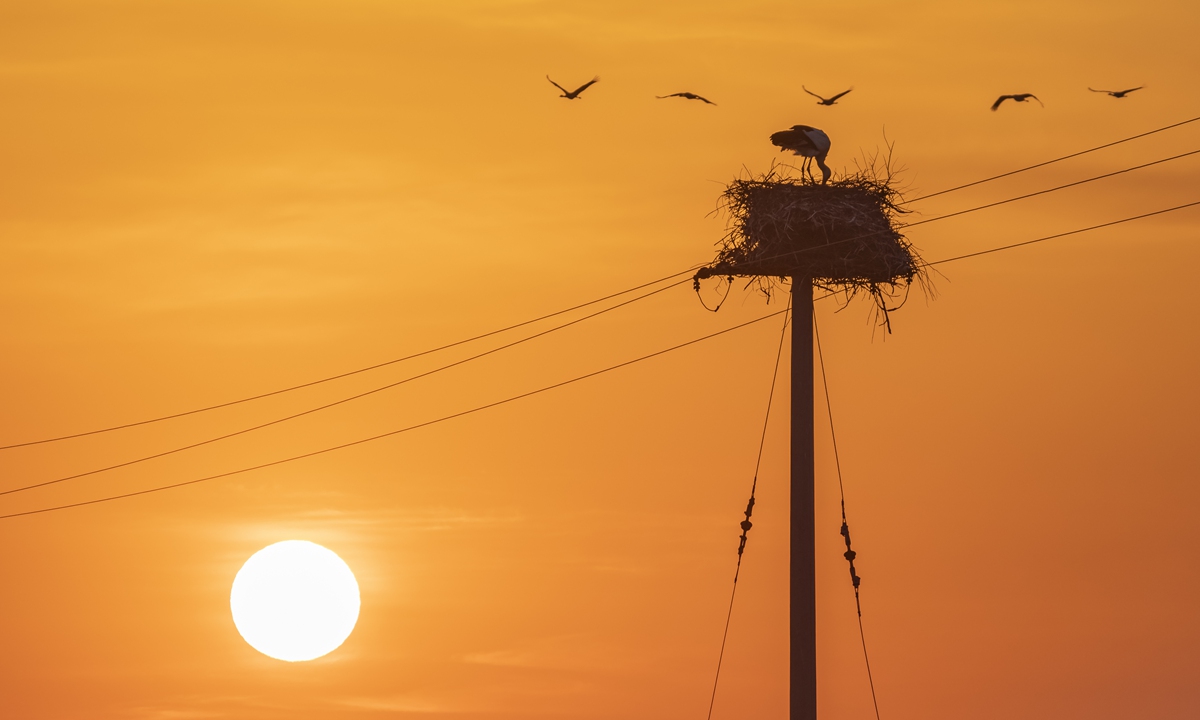
An Oriental White Stork stands in a nest as others fly in the morning glow in Dongying, East China's Shandong Province, on February 22, 2023. Photo: VCG
As people now enter the Yellow River Delta National Nature Reserve, they can see an interesting phenomenon: Every few meters in the vast wetland, there are cement poles erected by humans, and on each such pole is perched at least one Oriental White Stork guarding their nest.The season is the peak breeding period for birds in the reserve. For them, the spring in the Yellow River Delta is undoubtedly warm and cozy.
On the large screen of the Yellow River Delta Environmental Monitoring Center, a Global Times reporter saw in real-time footage of an adult Oriental White Stork caring for its newly hatched chicks in a nest, while occasionally picking up grass to feather the nest, providing a warm and comfortable home for its offspring.
Located at the intersection of the river and the sea, the Yellow River Delta has a complete warm temperate wetland ecosystem. This protected area has become an important stopover for wintering migratory birds that use it as a breeding ground. It is the second-largest breeding ground for the Black-tailed Gull and the second-largest wintering ground for the White Crane worldwide and a globally important breeding ground for the Oriental White Stork.
On top of each cement pole in the reserve, there is a bowl-shaped container installed. The reserve's staff members jokingly called the structures used by birds such as the Oriental White Stork for nesting purposes "public rental houses."
"Birds such as Oriental White Storks are very particular about their nesting environment. In order to give them a stable home, we set up artificial nests and breeding islands in the reserve," Zhao Yajie, deputy director of the Yellow River Delta Environmental Monitoring Center, told the Global Times.
Having worked in the Yellow River Delta for more than nine years, and wearing chest-high, airtight one-piece rubber pants while carrying binoculars, tripods, cameras, and other equipment weighing more than 10 pounds to monitor birds and wetland plants in the muddy mudflats all year round, Zhao still believes it to be a rewarding endeavor.
It is all because she has witnessed countless storks, Black-tailed Gull, and other birds come to this land, and watched their chicks hatch and grow up, and also witnessed the growth and expansion of the protection team.
This vast expanse of wetlands is a source of great hope.
In 2022, the reserve introduced a real-time monitoring system for birds by using information technology such as the Internet, big data, remote sensors and radar.
"We set up a 24-hour monitoring system at key locations such as bird distribution areas and road nodes. When birds enter the monitoring area, they can be automatically identified, recorded, and even counted," Zhao elaborated, noting that at present, the reserve has installed more than 50 video surveillance locations and identified over 135 birds of national key protection sites by employing satellite tracking.
Since the 1990s, the frequent disruption of the Yellow River has caused river channel shrinkage, wetland degradation, and the reduction of biological species in the Yellow River Delta, posing a serious threat to the wetland's ecological balance.
In recent years, Dongying has implemented more than a dozen ecological restoration projects based on water connectivity while dredging 41 kilometers of wetland water systems, opening up "capillary vessels" between the Yellow River and the wetland.
Statistics revealed that the reserve invested 65 million yuan ($9.4 million) to build 6 Yellow River sluice gates, and restored 41.6 kilometers of an ecological dyke of plants. In the last three years, the ecological water supply in the reserve has exceeded 480 million cubic meters.
"Ecological water replenishment provides sufficient water and food resources for birds. At present, the cumulative breeding number of Oriental White Stork chicks in the reserve has reached 2,748, and the number of bird species has increased from 187 in 1992 to 373 at present," Zhao said.
Zhao said that currently, Dongying is speeding up the establishment of the Yellow River Estuary National Park, while striving to explore more ways for the ecological protection and management of the great river.
"In the future, this land will be even more vibrant," she said with certainty.
